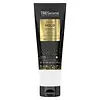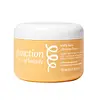What's inside
What's inside
 Benefits
Benefits

 Concerns
Concerns

 Ingredients Side-by-side
Ingredients Side-by-side

Water
Skin ConditioningVp/Dimethylaminoethylmethacrylate Copolymer
PPG-5-Ceteth-20
EmulsifyingPhenoxyethanol
PreservativeTriisopropanolamine
BufferingOleth-20
CleansingCarbomer
Emulsion StabilisingCaprylyl Glycol
EmollientPvp
Emulsion StabilisingSorbitol
HumectantParfum
MaskingPropylene Glycol
HumectantPEG-12 Dimethicone
Skin ConditioningDisodium EDTA
Panthenol
Skin ConditioningBenzyl Alcohol
PerfumingCitronellol
PerfumingGeraniol
PerfumingHexyl Cinnamal
PerfumingLimonene
PerfumingLinalool
PerfumingCI 60730
Cosmetic ColorantWater, Vp/Dimethylaminoethylmethacrylate Copolymer, PPG-5-Ceteth-20, Phenoxyethanol, Triisopropanolamine, Oleth-20, Carbomer, Caprylyl Glycol, Pvp, Sorbitol, Parfum, Propylene Glycol, PEG-12 Dimethicone, Disodium EDTA, Panthenol, Benzyl Alcohol, Citronellol, Geraniol, Hexyl Cinnamal, Limonene, Linalool, CI 60730
Water
Skin ConditioningGlycerin
HumectantPolyacrylate Crosspolymer-6
Emulsion StabilisingPPG-5-Ceteth-20
EmulsifyingHydrolyzed Ceratonia Siliqua Seed Extract
Skin ConditioningCaesalpinia Spinosa Fruit Extract
Skin ProtectingHelianthus Annuus Sprout Extract
Skin ConditioningPanthenol
Skin ConditioningGuar Hydroxypropyltrimonium Chloride
Skin ConditioningZea Mays Starch
AbsorbentAcacia Senegal Gum
MaskingPvp
Emulsion StabilisingXanthan Gum
EmulsifyingMaltodextrin/Vp Copolymer
Ethylhexylglycerin
Skin ConditioningPropylene Glycol
HumectantBenzoic Acid
MaskingDisodium EDTA
Dehydroacetic Acid
PreservativePhenoxyethanol
PreservativeSodium Benzoate
MaskingParfum
MaskingPotassium Sorbate
PreservativePolyquaternium-7
T-Butyl Alcohol
PerfumingLinalool
PerfumingLimonene
PerfumingHexyl Cinnamal
PerfumingBenzyl Salicylate
PerfumingAmyl Cinnamal
PerfumingCitral
PerfumingWater, Glycerin, Polyacrylate Crosspolymer-6, PPG-5-Ceteth-20, Hydrolyzed Ceratonia Siliqua Seed Extract, Caesalpinia Spinosa Fruit Extract, Helianthus Annuus Sprout Extract, Panthenol, Guar Hydroxypropyltrimonium Chloride, Zea Mays Starch, Acacia Senegal Gum, Pvp, Xanthan Gum, Maltodextrin/Vp Copolymer, Ethylhexylglycerin, Propylene Glycol, Benzoic Acid, Disodium EDTA, Dehydroacetic Acid, Phenoxyethanol, Sodium Benzoate, Parfum, Potassium Sorbate, Polyquaternium-7, T-Butyl Alcohol, Linalool, Limonene, Hexyl Cinnamal, Benzyl Salicylate, Amyl Cinnamal, Citral
Ingredients Explained
These ingredients are found in both products.
Ingredients higher up in an ingredient list are typically present in a larger amount.
Disodium EDTA plays a role in making products more stable by aiding other preservatives.
It is a chelating agent, meaning it neutralizes metal ions that may be found in a product.
Disodium EDTA is a salt of edetic acid and is found to be safe in cosmetic ingredients.
Learn more about Disodium EDTAHexyl Cinnamal is a fragrance ingredient with a similar scent to jasmine. It can be naturally found in chamomile essential oil.
This ingredient is a known EU allergen and may sensitize the skin. The EU requires this ingredient to be listed separately on an ingredients list.
Hexyl Cinnamal is not water soluble but is soluble in oils.
Learn more about Hexyl CinnamalLimonene is a fragrance that adds scent and taste to a formulation.
It's found in the peel oil of citrus fruits and other plants such as lavender and eucalyptus. The scent of limonene is generally described as "sweet citrus".
Limonene acts as an antioxidant, meaning it helps neutralize free radicals.
When exposed to air, oxidized limonene may sensitize the skin. Because of this, limonene is often avoided by people with sensitive skin.
The term 'fragrance' is not regulated in many countries. In many cases, it is up to the brand to define this term. For instance, many brands choose to label themselves as "fragrance-free" because they are not using synthetic fragrances. However, their products may still contain ingredients such as essential oils that are considered a fragrance.
Learn more about LimoneneLinalool is a fragrance and helps add scent to products. It's derived from common plants such as cinnamon, mint, citrus, and lavender.
Like Limonene, this ingredient oxidizes when exposed to air. Oxidized linalool can cause allergies and skin sensitivity.
This ingredient has a scent that is floral, spicy tropical, and citrus-like.
Learn more about LinaloolPanthenol is a common ingredient that helps hydrate and soothe the skin. It is found naturally in our skin and hair.
There are two forms of panthenol: D and L.
D-panthenol is also known as dexpanthenol. Most cosmetics use dexpanthenol or a mixture of D and L-panthenol.
Panthenol is famous due to its ability to go deeper into the skin's layers. Using this ingredient has numerous pros (and no cons):
Like hyaluronic acid, panthenol is a humectant. Humectants are able to bind and hold large amounts of water to keep skin hydrated.
This ingredient works well for wound healing. It works by increasing tissue in the wound and helps close open wounds.
Once oxidized, panthenol converts to pantothenic acid. Panthothenic acid is found in all living cells.
This ingredient is also referred to as pro-vitamin B5.
Learn more about PanthenolParfum is a catch-all term for an ingredient or more that is used to give a scent to products.
Also called "fragrance", this ingredient can be a blend of hundreds of chemicals or plant oils. This means every product with "fragrance" or "parfum" in the ingredients list is a different mixture.
For instance, Habanolide is a proprietary trade name for a specific aroma chemical. When used as a fragrance ingredient in cosmetics, most aroma chemicals fall under the broad labeling category of “FRAGRANCE” or “PARFUM” according to EU and US regulations.
The term 'parfum' or 'fragrance' is not regulated in many countries. In many cases, it is up to the brand to define this term.
For instance, many brands choose to label themselves as "fragrance-free" because they are not using synthetic fragrances. However, their products may still contain ingredients such as essential oils that are considered a fragrance by INCI standards.
One example is Calendula flower extract. Calendula is an essential oil that still imparts a scent or 'fragrance'.
Depending on the blend, the ingredients in the mixture can cause allergies and sensitivities on the skin. Some ingredients that are known EU allergens include linalool and citronellol.
Parfum can also be used to mask or cover an unpleasant scent.
The bottom line is: not all fragrances/parfum/ingredients are created equally. If you are worried about fragrances, we recommend taking a closer look at an ingredient. And of course, we always recommend speaking with a professional.
Learn more about ParfumPhenoxyethanol is a preservative that has germicide, antimicrobial, and aromatic properties. Studies show that phenoxyethanol can prevent microbial growth. By itself, it has a scent that is similar to that of a rose.
It's often used in formulations along with Caprylyl Glycol to preserve the shelf life of products.
We don't have a description for PPG-5-Ceteth-20 yet.
Propylene Glycol is an odorless, colorless liquid. As a humectant, it helps skin retain moisture. It also aids in delivering active ingredients.
Another role of this ingredient is preventing a product from melting or freezing. Propylene glycol also adds antimicrobrial properties to a product, elongating product lifespan.
This ingredient is considered an organic alcohol and commonly added into both cosmetics and foods.
Those with sensitive skin or conditions may develop a rash when using this ingredient.
Learn more about Propylene GlycolPvp is a water-soluble synthetic polymer and common hairstyling ingredient. It is a film-forming ingredient and used to "hold" specific shapes of hair.
Pvp is less effective in high-humidity. It tends to draw moisture, but this moisture dismantles the structure and "hold".
Water. It's the most common cosmetic ingredient of all. You'll usually see it at the top of ingredient lists, meaning that it makes up the largest part of the product.
So why is it so popular? Water most often acts as a solvent - this means that it helps dissolve other ingredients into the formulation.
You'll also recognize water as that liquid we all need to stay alive. If you see this, drink a glass of water. Stay hydrated!
Learn more about Water